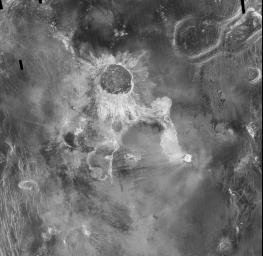Venus - Impact Crater ‘Isabella
Caption:
Crater Isabella, with a diameter of 175 kilometers (108 miles), seen in this Magellan radar image, is the second largest impact crater on Venus. The feature is named in honor of the 15th Century queen of Spain, Isabella of Castile. Located at 30 degrees south latitude, 204 degrees east longitude, the crater has two extensive flow-like structures extending to the south and to the southeast. The end of the southern flow partially surrounds a pre-existing 40 kilometer (25 mile) circular volcanic shield. The southeastern flow shows a complex pattern of channels and flow lobes, and is overlain at its southeastern tip by deposits from a later 20 kilometer (12 mile) diameter impact crater, Cohn (for Carola Cohn, Australian artist, 1892-1964). The extensive flows, unique to Venusian impact craters, are a continuing subject of study for a number of planetary scientists. It is thought that the flows may consist of 'impact melt,' rock melted by the intense heat released in the impact explosion. An alternate hypothesis invokes 'debris flows,' which may consist of clouds of hot gases and both melted and solid rock fragments that race across the landscape during the impact event. That type of emplacement process is similar to that which occurs in violent eruptions on Earth, such as the 1991 Mount Pinatubo eruption in the Philippines.
Cataloging Keywords:
| Name |
Value |
Additional Values |
| Target |
Venus |
|
| System |
|
|
| Target Type |
Planet |
|
| Mission |
Magellan |
|
| Instrument Host |
Magellan |
|
| Host Type |
Orbiter |
|
| Instrument |
Imaging Radar |
|
| Detector |
|
|
| Extra Keywords |
Artwork, Crater, Grayscale, Impact, Radar, Volcano |
| Acquisition Date |
|
| Release Date |
1996-11-26 |
| Date in Caption |
|
|
| Image Credit |
NASA/JPL |
| Source |
photojournal.jpl.nasa.gov/catalog/PIA00480 |
| Identifier |
PIA00480 |

